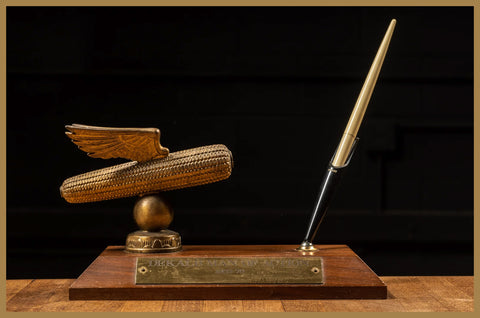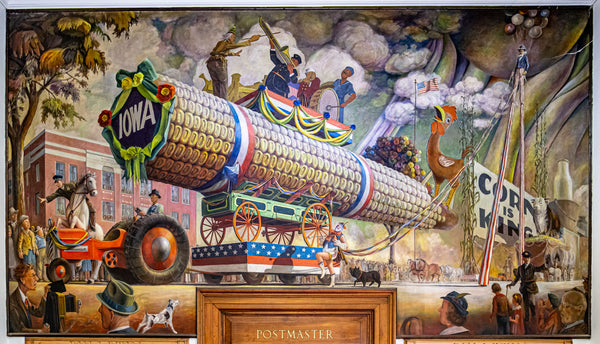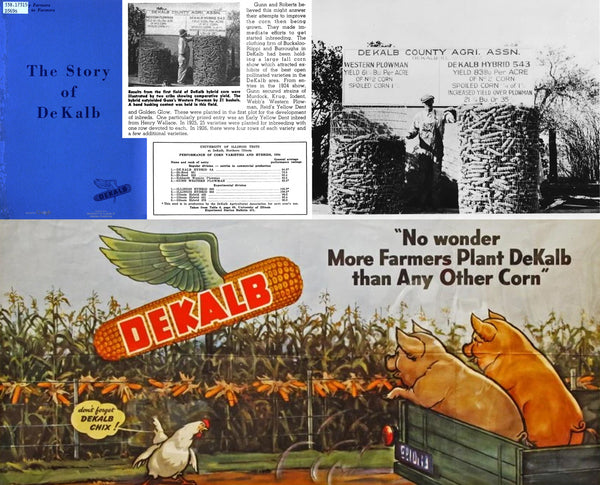DeKalb Hybrid Seed, or DeKalb Genetics Corporation, has its roots in our local history starting from 1912 in the wake of the 1911 American Farm Bureau movement that pooled negotiating power of farmers for purchasing of supplies and seeds. Whereas local co-ops could help farmers and ranchers with local business, food producers still had little sway on a national level, making it difficult for fair business practices, especially if an industry crossed state lines. In 1982 DeKalb Seed joined with Pfizer to form DeKalb-Pfizer Genetics (later called DeKalb Corporation). Monsanto purchased 40% of DeKalb in 1996 and the rest of the company in 1998. In 2018, Bayer acquired Monsanto, leading to what some will call the ‘worst corporate mergers in history.’ But we’re here for the corn, so let’s get to some history.
CORN MOTHER TEOSINTE
The history of corn is one of spontaneous cooperation between tribes stretching from what we now call South America to Canada. Originally from the Balsas River Valley of south-central Mexico, teosinte is a tall grass grain originally with seeds with a hard exterior, making it impractical for consumption. The stalk is sweet like sugar, so it made it popular for the indigenous to chew.
Sometime around 9,000 years ago a genetic mutation of teosinte thinned the hard outer layer of the grain. Locals were quick to exploit the benefit by cultivating parviglumis teosinte - which was not just nutritious but also delicious. It was easy to harvest, could be stored for long periods of time, and was versatile in use. As the first domesticators shared their seeds along trade routes, other civilizations north and south of the Mexico/Guatemala would form their own versions of maize creating larger grains that would modify to different climates. About 7,000 years ago, maize was successfully growing outside its original climate, making its way into what is now the southern United States. Around 2,000 years ago, it finally made it up to our area, what we know as the midwest.
Below is the mural Evolution of Corn (1938) by Lowell Houser (1902-1971) that sits on the north wall of the Ames, Iowa Post Offices, less than a mile from Rico's Tacos. You can find out more at the Ames History Museum by clicking HERE.
Out of all the aspects of food history, maize is one of the most unique examples of communal hybrid genetics that was part of a collective effort of all the indigenous peoples across North and South America, from Canada to Chile, giving birth to a long legacy of corn hybrid genetics that continues to this day.
THE BIG YELLOW DENT
By the 1850s, settlers across the country also found themselves producing various different kinds of corn that all had different sizes, shapes, and tastes. Once again, humans in agriculture found themselves cultivating different strains of corn, and sharing it with others, but nationally, it made it difficult to trade. If a family liked the corn from Indiana, but a seller only had corns from Wisconsin, Minnesota, Iowa, and South Dakota, a buyer wouldn’t know which one would be a suitable alternative.
This was solved at the 1893 Columbia’s Exposition World Fair in Chicago where James L. Reid’s Yellow Dent Corn won the blue ribbon, giving trade unions and farmers the opportunity to have a standardized corn that would appeal to everyone, and bring some consistency to the cultivation of maize.
In the late 1800s Reid’s Yellow Dent Corn swept the midwest, but with it came the depletion of nitrogen in the soil and overconsumption of water. Meanwhile, trade unions and large companies were short handing and strong arming local famers. This lead to the 1911 American Farm Bureau movement, later became the American Farm Bureau Federation in 1919.
DEKALB SEED
DeKalb Seed begins its teosinte phase in 1911 as DeKalb County Soil Improvement Association, lead by Henry H. Parke, focused on improving soil conditions and consistent crop yields. The DeKalb County Soil Improvement Association (SIA) was incorporated on March 27, 1912 with Dillon Brown elected president and Henry Parke elected secretary-treasurer. The group would later be lead by Charles Gunn and Thomas Roberts, Sr. and maintained a mission of focusing on producing hybrid corn seeds to produce higher yields with more disease resistance.
The United States passed the Smith-Lever Act’s 1914 Cooperative Extension which formed a partnership between the Department of Agriculture and land-grant universities. This made the future of farming for the country a joint venture between universities, giving them the ability to share information and research in farming, agriculture, food production, and development of hybrid seeds. Except DeKalb said, “No thanks."
While DeKalb County remained an independent local co-op, Thomas Roberts, Sr. and Charles Gunn, the DeKalb Agricultural Association spent 12 years perfecting a hybrid corn seed… a DeKalb Seed… and introduced it to the world starting in 1935. Farmers were treated as dealers, and not just buyers, not only incentivizing the use of the corn, but expanding the presence of one of the most reliable, consistent, and tasty corn crops across the country. From the 1940s until the 1980s, DeKalb Seed would lead the United States as the number one hybrid corn supplier.
HOW MUCH IS MY DEKALB SEED SIGN WORTH?
DeKalb Seed signs are pretty reasonably priced, although some of the more custom-made artifacts are not. Most of the signs between 18" to 36" wide will fetch from between 100-300 dollars in today's market - smaller signs will be under that, and larger signs would be more depending on condition and materials. Most of the signs we see are made out of masonite, and having one in good condition from the mid-1900s can certainly bring more than $500, as seen below
There are 2 deviations from this norm, one is easily explained and one is not. The one that's easy to understand are DeKalb Ag/Genetics/Seed artifacts like pen holders and ashtrays. Because of the delicate winged cob, finding an in-tact artifact is a great find and can command north of $200... as long as all the extended parts are without cracks, breaks, or fixes.
The second deviation is with these red signs pictured below and the orange dealer signs where the cob has golden wings. This is what we know: Sometime around 2015 these signs entered the market. Some of these were new-old stock (NOS) - signs that are mint or near-mint that display as "new." This exchange maintained a 250-400 dollar range for a few years until 2019, and then disappeared from the market. Typically, a 250-400 dollar sign in 2015 would expect to see their value double in 2024.
It seems people who own these signs aren't keen on giving them up, so we don't see them pop up often. If you run across one, let us know. We're always looking to buy, and you can EMAIL US pics.
IOWA ART
Two of the pics in this post come from post offices from Iowa - a state with a long, and endearing love of public art. Former Hawkeye and current writer Jon Darsee wrote THIS article for the Des Moines Register that includes a map of public post office art. Iowa Arts and Culture has an excellent Community Mural Toolkit available HERE.
Around here, we not only support local businesses, historical societies, and museums, but local artists as well.
















Leave a comment